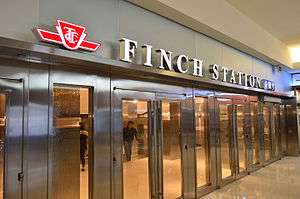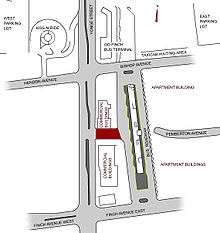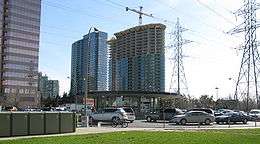Finch (TTC)
 Finch Station Entrance at North America Centre | |||||||||||
| Location |
5600 Yonge Street Toronto, Ontario Canada | ||||||||||
| Coordinates | 43°46′50″N 79°24′53″W / 43.78056°N 79.41472°WCoordinates: 43°46′50″N 79°24′53″W / 43.78056°N 79.41472°W | ||||||||||
| Platforms | centre platform | ||||||||||
| Tracks | 2 | ||||||||||
| Connections |
| ||||||||||
| Construction | |||||||||||
| Structure type | underground | ||||||||||
| Parking | 3,251 | ||||||||||
| Disabled access | Yes | ||||||||||
| History | |||||||||||
| Opened | 29 March 1974 | ||||||||||
| Traffic | |||||||||||
| Passengers (2014[1]) | 90,910 | ||||||||||
| Rank | 6th of 69 | ||||||||||
| Services | |||||||||||
| |||||||||||
Finch is the northern terminus subway station of the Yonge Street section of Line 1 Yonge–University in Toronto, Ontario, Canada. It is located under Yonge Street north of Finch Avenue.[2]
Finch is the busiest TTC bus terminal and the sixth-busiest subway station, serving around 90,910 people per day. The station connects with other transit agencies at the adjoining Finch Bus Terminal.
History
The station was opened on March 29, 1974, in what was then the Borough of North York, by provincial premier Bill Davis and borough mayor Mel Lastman. It replaced York Mills as the northern terminus of the line. Homes which once fronted the station along Yonge Street were demolished. Finch was created using the cut-and-cover technique as a way to save money.[3]
In 1999, this station became accessible with elevators.
In April 2006, work began on creating a new exit from the bus station on the western stub of Pemberton Avenue. This new exit was created because of the congestion that was created during the rush hour periods.[4] Not only did the congestion affect customers entering or leaving the station, it also caused long delays for cars around Bishop Avenue. In the morning rush hour, buses took an average of 1 minute and 58 seconds to travel the 40 metres from the station to Yonge Street, with some waiting up to 4 minutes.[4] The new exit was completed in January 2007.
Station description

Station layout and features
Stairs, escalators, and elevators lead from the bus platform down three levels to the train platform. The upper concourse, one floor below the bus platform, is a corridor running the length of the bus platform. It collects the landings of all of the terminal's stairs and escalators and leads to another bank of stairs and escalators down to the lower concourse.[2]
The lower concourse level is the main concourse of the subway station. It is divided into the fare-paid and unpaid areas. The unpaid area is a long corridor, part of which runs alongside the fare-paid area lined with several automated token/pass and manned entrances. The unpaid area contains connections to office towers (North American Life, Place Nouveau, and condominiums on Pemberton Avenue), the regional bus terminal, and the “Kiss-n-Ride” passenger drop-off facility; it also contains token machines. The fare-paid area houses a few shops, including Gateway Newstands and Tim Hortons, florist, lottery booth, clothing shop, and stairs and escalators down to the subway platform.[2]
Entrances
Passengers can enter the station from eight different entrances located in the Finch Avenue and Yonge Street area. Accessible entrances can be found on Yonge Street at Heldon Avenue, by the Finch Bus Terminal, and at the North American Centre. Other non-accessible entrances can be found at 5775 and 5765 Yonge Street, Pemberton Avenue, and at the northeast corner of the Yonge Street and Finch Avenue intersection.[2]
There is an emergency exit between Finch and North York Centre stations at the northeast corner of Church Avenue and Yonge Street. The site was once the Willowdale United Church, demolished to make way for subway construction. Stairs from the subway tunnel surface into a brick building in the old cemetery.
Parking lots and passenger drop-off facility

There are two major TTC parking lots (referred to as the car park in directional signage) at Finch Station for use by commuters. They are called simply the East Lot and the West Lot, and are located north of Bishop/Hendon, east and west of Yonge Street respectively. The lots have a combined capacity of 3251 parking spaces. Since the TTC got rid of free parking for Metropass holders, these lots rarely fill up. As of January 1, 2012, parking costs $5 from 5:00am to 3:00pm on weekdays, $2 between 3:00pm and 2:00am, and free all-day on weekends and holidays.[5]
In addition to the parking lots, Finch Station also features a relatively elaborate “Kiss-n-Ride” passenger drop-off/pick-up facility, which is connected to the lower concourse level of the station (outside the fare-paid area) by pedestrian tunnels. The area has a round, indoor waiting area for passengers, with about 20 temporary parking spaces circularly surrounding the structure. It is adjacent to the west parking lot. Many people also use the aforementioned Pemberton Avenue cul-de-sac and Bishop Avenue's proximity to the station's entrance as a pick-up and drop-off point, especially during busy hours when the Kiss-n-Ride area may be full. Although it is technically illegal for cars to stop or park in this area, it is almost always overlooked.
On the north side of Bishop Avenue, slightly east of the station (along the southern edge of the GO bus terminal) is a parking lane for taxicabs. This is best accessed by exiting the subway station at the stairs/escalator to the north-east corner of Yonge and Bishop (the GO bus terminal).
Architecture and art
Krystyna Sadowska's sculpture Rhythm of Exotic Plants (1965) is displayed on the lower concourse level, outside the fare-paid area; A stainless-steel plaque celebrating the station's opening is also located on the lower concourse. A smaller plaque is located at the south subway platform.
Subway infrastructure in the vicinity
North of the station, there are tail tracks on the ends of both tracks to store subway cars. South of the station, there is a double crossover for arriving trains to enter either one of the two tracks into the station, and for departing trains to crossover to the southbound track.
Surface connections
The bus platform at Finch Station is within the fare-paid area, so pedestrians wishing to board buses need to use the subway station entrance. The exceptions are route 97 southbound and the Blue Night Bus, which use curbside stops on the street outside the station.[2]
Finch Bus Terminal is just north of the TTC station and is connected by a tunnel under Bishop Avenue. That bus station is used by GO Transit and York Region Transit services, including two BRT lines of York Region's Viva Rapid Transit, this access is NOT in the fare paid area.
- 36A Finch West to Humberwood Boulevard
- 36D to Weston Road and Milvan Drive (Rush hour service)
- 36F to Weston Road and Milvan Drive via Fenmar Drive (Rush hour service)
- 39A Finch East to Neilson Road
- 39B to Old Finch Avenue and Morningview Avenue
- 39C to Victoria Park Avenue and Gordon Barker Road (Rush hour service)
- 42A Cummer to Middlefield Road and Dynamic Drive
- 42B to Kennedy Road
- 42C to Victoria Park Avenue (Rush hour service)
- 53A Steeles East to Staines Road
- 53B to Markham Road
- 53E to Markham Road (Express service)
- 53F to Staines (Express service)
- 60B Steeles West to Martin Grove Road
- 60C to York University
- 60D to Highway 27
- 60F to York University (Express service)
- 97B Yonge to Steeles Avenue
- 97C to Steeles Avenue
- 97F to Steeles Avenue
- 125 Drewry to Bathurst Street (Torresdale)
- 199A Finch Rocket eastbound to Scarborough Centre Station
- 199B westbound to York University
- 199C eastbound to Morningside Heights
- 336 Blue Night Finch West to Woodbine Race Track
- 339 Blue Night Finch East to Markham Road
- 320 Blue Night Yonge northbound to Steeles Avenue
- 320 southbound to Queens Quay
- WheelTrans also makes connections to the accessible station.
Nearby landmarks
- Plaque on the North American Life building commemorating the birthplace of former Canadian Prime Minister Lester B. Pearson
- Newtonbrook Plaza
- Finch's Hotel (historic landmark that no longer exists)
Expansion plans
On 15 June 2007, Premier Dalton McGuinty announced a plan to extend the Yonge Subway from Finch Station to Highway 7 in Richmond Hill by 2020 as part of the government's MoveOntario 2020 plan. As of 2008, the plans for a north Yonge extension have become less of a priority with focus shifting to the possibility resurrecting plans for the Downtown Relief Line.[6]
The Transit City proposal calls for a new LRT line, known as the Etobicoke-Finch West LRT line, to run along Finch Avenue West from Humber College to Finch Station. Phasing of the line would result in the eastern section beyond Keele Street being built at a later date.
References
- ↑ "Subway ridership, 2014" (PDF). Toronto Transit Commission. Retrieved September 12, 2015.
This table shows the typical number of customer-trips made on each subway on an average weekday and the typical number of customers travelling to and from each station platform on an average weekday.
- 1 2 3 4 5 "TTC Finch Station". Toronto Transit Commission. Retrieved 13 August 2014.
- ↑ "The North Yonge Extensions". Transit Toronto. Retrieved 13 August 2014.
- 1 2 "TTC Report: Transit benefits of a new bus exit at Finch Station". Retrieved 23 February 2007.
- ↑ "TTC Finch Station Parking". Toronto Transit Commission. Retrieved 13 August 2014.
- ↑ Hertz, Barry (2008-04-15). "TTC to seriously consider relief line by 2018, Giambrone says". National Post. Retrieved 2009-10-28.
| Wikimedia Commons has media related to Finch Station. |
